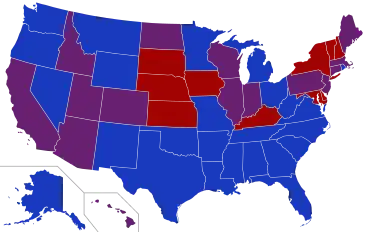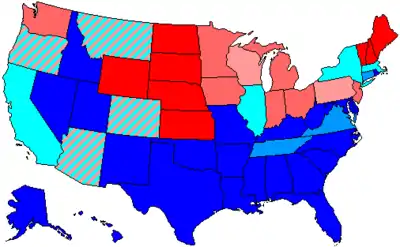| 87th United States Congress | |
|---|---|
86th ← → 88th | |
 United States Capitol (1962) | |
January 3, 1961 – January 3, 1963 | |
| Members | 100 senators 437 representatives |
| Senate majority | Democratic |
| Senate President | Richard Nixon (R)[lower-alpha 1] (until January 20, 1961) Lyndon B. Johnson (D) (from January 20, 1961) |
| House majority | Democratic |
| House Speaker | Sam Rayburn (D) John W. McCormack (D) |
| Sessions | |
| 1st: January 3, 1961 – September 27, 1961 2nd: January 10, 1962 – October 13, 1962 | |
The 87th United States Congress was a meeting of the legislative branch of the United States federal government, composed of the United States Senate and the United States House of Representatives. It met in Washington, D.C. from January 3, 1961, to January 3, 1963, during the final weeks of Dwight D. Eisenhower's presidency and the first two years of John Kennedy's presidency. The apportionment of seats in the House of Representatives was based on the 1950 United States census, along with two seats temporarily added in 1959 (one member each from recently admitted states of Alaska and Hawaii).
Both chambers had a Democratic majority (albeit reduced in the House). With President Kennedy being sworn in on January 20, 1961, this gave the Democrats an overall federal government trifecta for the first time since the 81st Congress in 1949.
Major events
- January 3, 1961: President Eisenhower severed diplomatic and consular relations with Cuba.
- January 20, 1961: Inauguration of President John F. Kennedy.
- April 17, 1961: Bay of Pigs Invasion of Cuba began; it fails by April 19.
- May 4, 1961: Freedom Riders began interstate bus rides to test the new U.S. Supreme Court integration decision.
- May 5, 1961: Alan Shepard became the first American in space aboard Mercury-Redstone 3.
- May 25, 1961: President Kennedy announced his goal to put a man on the Moon before the end of the decade
- November 20: 1961: Funeral of Speaker Sam Rayburn, who died on November 16
- February 3, 1962: Embargo against Cuba was announced
- February 20, 1962: John Glenn became the first American to orbit the Earth
- March 26, 1962: Supreme Court ruled that federal courts could order state legislatures to reapportion seats (Baker v. Carr)
- October 1, 1962: James Meredith registered as the first black student at the University of Mississippi, escorted by Federal Marshals.
- October 14, 1962 - October 28, 1962: Cuban Missile Crisis
Major legislation

- August 30, 1961 : Oil Pollution Act of 1961, Pub. L. 87–167, 75 Stat. 402
- September 4, 1961: The Foreign Assistance Act of 1961, Pub. L. 87–195, 75 Stat. 424
- September 13, 1961: Interstate Wire Act of 1961, Pub. L. 87–216, 75 Stat. 491
- September 21, 1961: Mutual Educational and Cultural Exchange Act of 1961, Pub. L. 87–256, 75 Stat. 527
- September 22, 1961: Peace Corps Act of 1961, Pub. L. 87–293, 75 Stat. 612
- September 26, 1961: Arms Control and Disarmament Act of 1961, Pub. L. 87–297, 75 Stat. 631
- October 15, 1961: Community Health Services and Facilities Act, Pub. L. 87–395, 75 Stat. 824
- March 15, 1962: Manpower Development and Training Act, Pub. L. 87–415, 76 Stat. 23
- June 28, 1962: Migration and Refugee Assistance Act, Pub. L. 87–510, 76 Stat. 121
- August 31, 1962: Communications Satellite Act, Pub. L. 87–624, 76 Stat. 419
- October 11, 1962: Trade Expansion Act, Pub. L. 87–794, 76 Stat. 872
Constitutional amendments
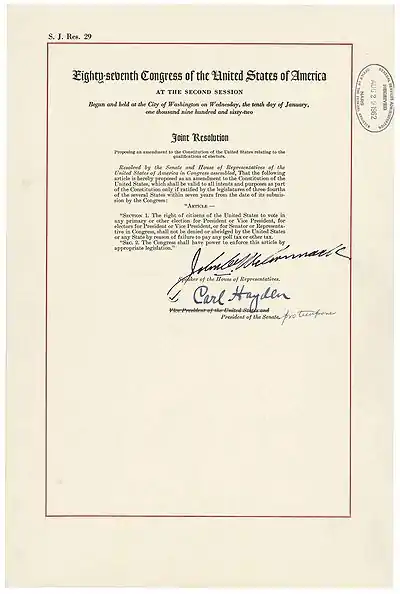
- March 29, 1961: Twenty-third Amendment ratified, extending the right to vote in the presidential election to citizens residing in the District of Columbia by granting the District electors in the Electoral College, as if it were a state.
- August 27, 1962: Twenty-fourth Amendment approved by Congress and sent to the states for consideration. It would prohibit both Congress and the states from conditioning the right to vote in federal elections on payment of a poll tax or other types of tax. The amendment was later ratified on January 23, 1964.
Party summary
Senate
| Party (shading shows control) |
Total | Vacant | ||
|---|---|---|---|---|
| Democratic (D) |
Republican (R) | |||
| End of previous congress | 66 | 34 | 100 | 0 |
| Begin | 65 | 35 | 100 | 0 |
| End | 62 | 37 | 99 | 1 |
| Final voting share | 62.6% | 37.4% | ||
| Beginning of next congress | 65 | 33 | 98 | 2 |
House of Representatives
| Party (shading shows control) |
Total | Vacant | ||
|---|---|---|---|---|
| Democratic (D) |
Republican (R) | |||
| End of previous congress | 281 | 151 | 432 | 5 |
| Begin | 263 | 174 | 437 | 0 |
| End | 260 | 434 | 3 | |
| Final voting share | 59.9% | 40.1% | ||
| Beginning of next congress | 258 | 176 | 434 | 1 |
Leadership
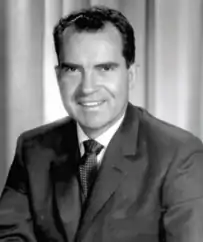
Until January 20, 1961

From January 20, 1961

Senate
- President: Richard Nixon (R), until January 20, 1961
- Lyndon B. Johnson (D), from January 20, 1961
- President pro tempore: Carl Hayden (D)
Majority (Democratic) leadership
Minority (Republican) leadership
- Minority Leader: Everett Dirksen
- Minority Whip: Thomas Kuchel
- Republican Conference Chairman: Leverett Saltonstall
- Republican Conference Secretary: Milton Young
- National Senatorial Committee Chair: Barry Goldwater
- Policy Committee Chairman: Styles Bridges (until November 26, 1961)
- Bourke B. Hickenlooper (from January 3, 1962)
House of Representatives
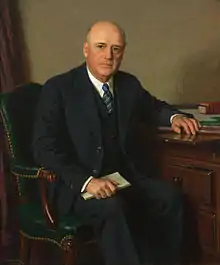
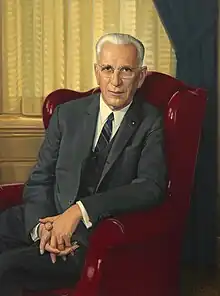
- Speaker: Sam Rayburn (D), until November 16, 1961
- John W. McCormack (D), from January 10, 1962
Majority (Democratic) leadership
- Majority Leader: John W. McCormack until January 10, 1962
- Carl Albert, from January 10, 1962
- Majority Whip: Carl Albert, until January 10, 1962
- Hale Boggs, from January 10, 1962
- Democratic Caucus Chairman: Francis E. Walter
- Democratic Caucus Secretary: Leonor Sullivan
- Democratic Campaign Committee Chairman: Michael J. Kirwan
Minority (Republican) leadership
Caucuses
Members
Senate
Senators are popularly elected statewide every two years, with one-third beginning new six-year terms with each Congress. Preceding the names in the list below are Senate class numbers, which indicate the cycle of their election, In this Congress, Class 3 meant their term ended with this Congress, requiring re-election in 1962; Class 1 meant their term began in the last Congress, requiring re-election in 1964; and Class 2 meant their term began in this Congress, requiring re-election in 1966.
Currently, this is the last Congressional session in which the Democratic Party commanded all Senate seats from the Deep South, a unity broken when a Republican defeated the appointed successor to Lyndon Johnson's seat in a 1961 Senate special election.
House of Representatives
The names of members of the House of Representatives are preceded by their district numbers.
Changes in membership
Senate
| State (class) |
Vacated by | Reason for change | Successor | Date of successor's formal installation[lower-alpha 3] |
|---|---|---|---|---|
| Texas (2) |
William A. Blakley (D) | Lost special election. Successor elected June 14, 1961. |
John Tower (R) | June 15, 1961 |
| New Hampshire (2) |
Styles Bridges (R) | Died November 26, 1961. Successor appointed December 7, 1961. |
Maurice J. Murphy Jr. (R) | December 7, 1961 |
| Kansas (2) |
Andrew Frank Schoeppel (R) | Died January 21, 1962. Successor appointed January 31, 1962, and then elected November 6, 1962. |
James B. Pearson (R) | January 31, 1962 |
| South Dakota (3) |
Francis H. Case (R) | Died June 23, 1962. Successor appointed July 9, 1962 to finish the term. |
Joseph H. Bottum (R) | July 9, 1962 |
| Idaho (2) |
Henry Dworshak (R) | Died July 23, 1962. Successor appointed August 6, 1962, and then elected November 6, 1962. |
Leonard B. Jordan (R) | August 6, 1962 |
| Wyoming (2) |
John J. Hickey (D) | Lost special election. Successor elected November 6, 1962. |
Milward Simpson (R) | November 6, 1962 |
| Massachusetts (1) |
Benjamin A. Smith II (D) | Successor elected November 6, 1962. | Ted Kennedy (D) | November 7, 1962 |
| New Hampshire (2) |
Maurice J. Murphy Jr. (R) | Lost special election. Successor elected November 6, 1962. |
Thomas J. McIntyre (D) | November 7, 1962 |
| New Mexico (1) |
Dennis Chávez (D) | Died November 18, 1962. Successor appointed November 30, 1962 to continue the term. |
Edwin L. Mechem (R) | November 30, 1962 |
| Oklahoma (2) |
Robert S. Kerr (D) | Died January 1, 1963. | Vacant | Not filled this term |
House of Representatives
| District | Vacated by | Reason for change | Successor | Date of successor's formal installation[lower-alpha 3] |
|---|---|---|---|---|
| Arizona 2nd | Stewart Udall (D) | Resigned January 18, 1961 to become United States Secretary of the Interior. | Mo Udall (D) | May 2, 1961 |
| Arkansas 6th | William F. Norrell (D) | Died February 15, 1961. | Catherine Dorris Norrell (D) | April 18, 1961 |
| Pennsylvania 16th | Walter M. Mumma (R) | Died February 25, 1961. | John C. Kunkel (R) | May 16, 1961 |
| Tennessee 1st | B. Carroll Reece (R) | Died March 19, 1961. | Louise Goff Reece (R) | May 16, 1961 |
| Louisiana 4th | Overton Brooks (D) | Died September 16, 1961. | Joe Waggonner (D) | December 19, 1961 |
| Michigan 1st | Thaddeus M. Machrowicz (D) | Resigned September 18, 1961 to become judge of the United States District Court for the Eastern District of Michigan. | Lucien Nedzi (D) | November 7, 1961 |
| Texas 20th | Paul J. Kilday (D) | Resigned September 24, 1961 to become judge of United States Court of Appeals for the Armed Forces. | Henry B. González (D) | November 4, 1961 |
| Michigan 14th | Louis C. Rabaut (D) | Died November 12, 1961. | Harold M. Ryan (D) | February 13, 1962 |
| Texas 4th | Sam Rayburn (D) | Died November 16, 1961. | Ray Roberts (D) | January 30, 1962 |
| Texas 13th | Frank N. Ikard (D) | Resigned December 15, 1961. | Graham B. Purcell Jr. (D) | January 27, 1962 |
| New York 6th | Lester Holtzman (D) | Resigned December 31, 1961 to become judge of the New York Supreme Court. | Benjamin Stanley Rosenthal (D) | February 20, 1962 |
| South Carolina 2nd | John J. Riley (D) | Died January 1, 1962. | Corinne Boyd Riley (D) | April 10, 1962 |
| New Jersey 11th | Hugh Joseph Addonizio (D) | Resigned June 30, 1962 to become Mayor of Newark, New Jersey. | Vacant | Not filled this term |
| California 1st | Clement Woodnutt Miller (D) | Died October 7, 1962. | ||
| Mississippi 3rd | Frank Ellis Smith (D) | Resigned November 14, 1962. |
Committees
Lists of committees and their party leaders for members of the House and Senate committees can be found through the Official Congressional Directory at the bottom of this article. The directory after the pages of terms of service lists committees of the Senate, House (Standing with Subcommittees, Select and Special) and Joint and, after that, House/Senate committee assignments. On the committees section of the House and Senate in the Official Congressional Directory, the committee's members on the first row on the left side shows the chairman of the committee and on the right side shows the ranking member of the committee.
Senate
- Aging: (Chairman: Pat McNamara; Ranking Member: )
- Aeronautical and Space Sciences (Chairman: Robert S. Kerr; Ranking Member: Styles Bridges, then Margaret Chase Smith)
- Agriculture and Forestry (Chairman: Allen J. Ellender; Ranking Member: George Aiken)
- Appropriations (Chairman: Carl Hayden; Ranking Member: Styles Bridges, then Leverett Saltonstall)
- Armed Services (Chairman: Richard B. Russell; Ranking Member: Leverett Saltonstall)
- Banking and Currency (Chairman: A. Willis Robertson; Ranking Member: Homer E. Capehart)
- District of Columbia (Chairman: Alan Bible; Ranking Member: J. Glenn Beall)
- Finance (Chairman: Harry F. Byrd; Ranking Member: John J. Williams)
- Foreign Relations (Chairman: J. William Fulbright; Ranking Member: Alexander Wiley)
- Government Operations (Chairman: John L. McClellan; Ranking Member: Karl Mundt)
- Interior and Insular Affairs (Chairman: Clinton P. Anderson; Ranking Member: Henry Dworshak, then Thomas Kuchel)
- Interstate and Foreign Commerce (Chairman: Warren G. Magnuson; Ranking Member: Andrew Frank Schoeppel, then Norris Cotton)
- Judiciary (Chairman: James O. Eastland; Ranking Member: Alexander Wiley)
- Labor and Public Welfare (Chairman: J. Lister Hill; Ranking Member: Barry Goldwater)
- National Fuels Study (Special)
- National Water Resources (Select)
- Post Office and Civil Service (Chairman: Olin D. Johnston; Ranking Member: Frank Carlson)
- Public Works (Chairman: Dennis Chavez; Ranking Member: Francis Case, then John Sherman Cooper)
- Rules and Administration (Chairman: Mike Mansfield; Ranking Member: Carl Curtis)
- Small Business (Select) (Chairman: John J. Sparkman; Ranking Member: )
- Subcommittee on Internal Security
- Whole
House of Representatives
- Agriculture (Chairman: Harold D. Cooley; Ranking Member: Charles B. Hoeven)
- Appropriations (Chairman: Clarence Cannon; Ranking Member: John Taber)
- Armed Services (Chairman: Carl Vinson; Ranking Member: Leslie C. Arends)
- Banking and Currency (Chairman: Brent Spence; Ranking Member: Clarence E. Kilburn)
- District of Columbia (Chairman: John L. McMillan; Ranking Member: James C. Auchincloss)
- Education and Labor (Chairman: Adam Clayton Powell; Ranking Member: Carroll D. Kearns)
- Export Control (Select) (Chairman: N/A; Ranking Member: N/A)
- Foreign Affairs (Chairman: Thomas E. Morgan; Ranking Member: Robert B. Chiperfield)
- Government Operations (Chairman: William L. Dawson; Ranking Member: Clare Hoffman)
- House Administration (Chairman: Omar Burleson; Ranking Member: Paul F. Schenck)
- Interior and Insular Affairs (Chairman: Wayne N. Aspinall; Ranking Member: John P. Saylor)
- Interstate and Foreign Commerce (Chairman: Oren Harris; Ranking Member: John B. Bennett)
- Judiciary (Chairman: Emanuel Celler; Ranking Member: William Moore McCulloch)
- Merchant Marine and Fisheries (Chairman: Herbert C. Bonner; Ranking Member: Thor C. Tollefson)
- Post Office and Civil Service (Chairman: Tom J. Murray; Ranking Member: Robert J. Corbett)
- Public Works (Chairman: Charles A. Buckley; Ranking Member: James C. Auchincloss)
- Rules (Chairman: Howard W. Smith; Ranking Member: Clarence J. Brown)
- Science and Astronautics (Chairman: Overton Brooks then George P. Miller; Ranking Member: Joseph W. Martin Jr.)
- Small Business (Select) (Chairman: Wright Patman; Ranking Member: )
- Standards of Official Conduct
- Un-American Activities (Chairman: Francis E. Walter; Ranking Member: Gordon H. Scherer)
- Veterans' Affairs (Chairman: Olin E. Teague; Vice Chairman: William Hanes Ayres)
- Ways and Means (Chairman: Wilbur D. Mills; Vice Chairman: Noah M. Mason)
- Whole
Joint committees
- Atomic Energy (Chairman: Rep. Chet Holifield; Vice Chairman: Sen. )
- Conditions of Indian Tribes (Special)
- Construction of a Building for a Museum of History and Technology for the Smithsonian
- Defense Production (Chairman: Sen. A. Willis Robertson; Vice Chairman: Rep. )
- Economic (Chairman: Rep. Wright Patman; Vice Chairman: Sen. )
- Immigration and Nationality Policy (Chairman: Vacant; Vice Chairman: Vacant)
- Legislative Budget
- The Library (Chairman: Rep. Omar Burleson; Vice Chairman: Sen. )
- Navajo-Hopi Indian Administration
- Printing (Chairman: Rep. Carl Hayden; Vice Chairman: Sen. )
- Reduction of Nonessential Federal Expenditures (Chairman: Sen. Harry F. Byrd; Vice Chairman: Rep. )
- Taxation (Chairman: Rep. Wilbur D. Mills; Vice Chairman: Sen. )
Employees
Legislative branch agency directors
- Architect of the Capitol: J. George Stewart
- Attending Physician of the United States Congress: George Calver
- Comptroller General of the United States: Joseph Campbell
- Librarian of Congress: Lawrence Quincy Mumford
- Public Printer of the United States: Raymond Blattenberger, until 1961
- James L. Harrison, from 1961
Senate
- Chaplain: Frederick Brown Harris (Methodist)
- Parliamentarian: Charles Watkins
- Secretary: Felton McLellan Johnston
- Librarian: Richard D. Hupman
- Secretary for the Majority: Robert G. Baker
- Secretary for the Minority: J. Mark Trice
- Sergeant at Arms: Joseph C. Duke
House of Representatives
- Chaplain: Bernard Braskamp (Presbyterian)
- Clerk: Ralph R. Roberts
- Doorkeeper: William Mosley "Fishbait" Miller
- Parliamentarian: Lewis Deschler
- Postmaster: H. H. Morris
- Reading Clerk: George J. Maurer (D) and Joe Bartlett (R)
- Sergeant at Arms: Zeake W. Johnson Jr.
See also
- 1960 United States elections (elections leading to this Congress)
- 1962 United States elections (elections during this Congress, leading to the next Congress)
Notes
- ↑ U.S. Vice President Richard Nixon's term as President of the Senate ended at noon January 20, 1961, when Lyndon B. Johnson's term began.
- ↑ In Wyoming, Senator-elect Edwin Keith Thomson (R) died December 9, 1960, before the term started.
- 1 2 When seated or oath administered, not necessarily when service began.
References
- ↑ "Proceedings and debates of the 87th Congress, first session" (PDF). Congressional Record. U.S. Government Publishing Office. January 3, 1961. p. 7.
- Martis, Kenneth C. (1989). The Historical Atlas of Political Parties in the United States Congress. New York: Macmillan Publishing Company.
- Martis, Kenneth C. (1982). The Historical Atlas of United States Congressional Districts. New York: Macmillan Publishing Company.
External links
- Biographical Directory of the U.S. Congress
- U.S. House of Representatives: Congressional History
- U.S. Senate: Statistics and Lists
- House of Representatives Session Calendar for the 87th Congress (PDF). Archived from the original (PDF) on September 20, 2018. Retrieved June 6, 2016.
- Official Congressional Directory for the 87th Congress, 1st Session.
- Official Congressional Directory for the 87th Congress, 2nd Session.
- Pocket Congressional Directory for the 87th Congress.
